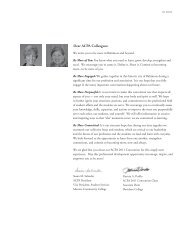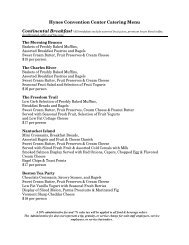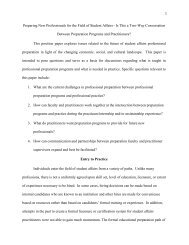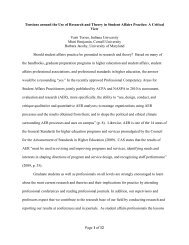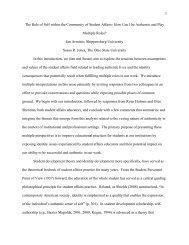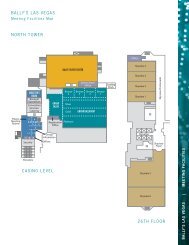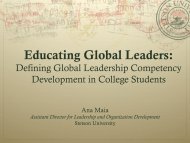Is Student Affairs Relevant for the 21st Century? Tony W. Cawthon ...
Is Student Affairs Relevant for the 21st Century? Tony W. Cawthon ...
Is Student Affairs Relevant for the 21st Century? Tony W. Cawthon ...
Create successful ePaper yourself
Turn your PDF publications into a flip-book with our unique Google optimized e-Paper software.
<strong>Is</strong> <strong>Student</strong> <strong>Affairs</strong> <strong>Relevant</strong> <strong>for</strong> <strong>the</strong> 21 st <strong>Century</strong>?<br />
<strong>Tony</strong> W. <strong>Cawthon</strong><br />
Clemson University<br />
Karen D. Boyd<br />
University of Central Florida<br />
Robert “Beau” Seagraves, Jr.<br />
University of Georgia<br />
1
<strong>Is</strong> <strong>Student</strong> <strong>Affairs</strong> <strong>Relevant</strong> <strong>for</strong> <strong>the</strong> 21 st <strong>Century</strong>?<br />
This monograph attempts to provide readers with thoughts and questions about <strong>the</strong><br />
relevancy of student affairs in <strong>the</strong> future. As we began our work on this monograph, we struggled<br />
with how to approach it as none of us has a crystal ball nor can we predict <strong>the</strong> future. In addition,<br />
a number of recent publications have addressed this same topic. The final report of <strong>the</strong> Task<br />
Force of <strong>the</strong> Future of <strong>Student</strong> <strong>Affairs</strong>, Envisioning <strong>the</strong> Future of <strong>Student</strong> <strong>Affairs</strong>, (ACPA &<br />
NASPA, Task Force of <strong>the</strong> Future of <strong>Student</strong> <strong>Affairs</strong>, 2010) and <strong>the</strong> report provides excellent<br />
in<strong>for</strong>mation on <strong>the</strong> future of student affairs. More recently, <strong>the</strong> Journal of College and Character<br />
offered two articles on <strong>the</strong> mission of student affairs. The first article Does <strong>Student</strong> <strong>Affairs</strong> Have<br />
an Enduring Mission (Sandeen, 2011), investigates if it is possible to agree on an enduring core<br />
mission and purpose of student affairs. The second article Redefining Our Mission: What Does<br />
Higher Education Need from <strong>Student</strong> <strong>Affairs</strong>? (Porterfield, Roper, L., & Whitt, 2011) focuses on<br />
<strong>the</strong> premise that student affairs’ ability to remain relevant is reliant upon our ability to redefine<br />
our mission, structures and best practices in conjunction with <strong>the</strong> needs of <strong>the</strong> institution.<br />
To begin our work on this manuscript, we began by identifying four questions we hoped<br />
to address. The questions used to frame this manuscript were:<br />
(1) In <strong>the</strong> last 10 years, how has <strong>the</strong> state of <strong>the</strong> economy, politics, and o<strong>the</strong>r social<br />
variables changed <strong>the</strong> mission of student affairs?<br />
(2) How will <strong>the</strong> mission of student affairs change in <strong>the</strong> next 10 years in <strong>the</strong> following<br />
areas?<br />
-Will our organization structures remain <strong>the</strong> same? If not, <strong>the</strong>n how do you predict<br />
<strong>Student</strong> <strong>Affairs</strong> will be organized in 2020?<br />
2
-Which current priorities are sustainable? Which are not?<br />
-What excites you about student affairs in 2020?<br />
- What concerns you about student affairs in 2020?<br />
(3). When thinking about our colleagues in higher education (administration, faculty and<br />
students), do you believe <strong>the</strong>y view student affairs professionals, programs and activities<br />
as relevant to <strong>the</strong> needs of our respective institutions and student bodies? Please explain<br />
why or why not?<br />
(4). In 2012, we will celebrate <strong>the</strong> 75 th anniversary of <strong>the</strong> <strong>Student</strong> Personnel Point of<br />
View. (SPPV). With that in mind, “<strong>Is</strong> student affairs relevant to institutions, society and<br />
is it still guided by <strong>the</strong> SPPV?<br />
To address our work, we began by reading <strong>the</strong>se three recent documents mentioned<br />
above. In addition, we thought it was important to refamiliarize ourselves with <strong>the</strong> key historical<br />
documents that have influence student affairs. Many documents have been written, but our<br />
approach was to utilize <strong>the</strong> documents housed on <strong>Student</strong> <strong>Affairs</strong> History Project website<br />
(Bowling Green State University, http://www.bgsu.edu/colleges/library/cac/sahp/). From this<br />
site, we reviewed <strong>the</strong> following documents: (a) The <strong>Student</strong> Personnel Point of View, 1937; 1949<br />
(American Council on Education, 1937, 1949); (b) <strong>Student</strong> Development in Tomorrow's Higher<br />
Education: A Return to <strong>the</strong> Academy (Brown, 1972), (c) The Future of <strong>Student</strong> <strong>Affairs</strong> (Miller &<br />
Prince, 1976); (d) A Perspective on <strong>Student</strong> <strong>Affairs</strong> (AAHE/ACPA/NASPA, 1987); (e) The<br />
<strong>Student</strong> Learning Imperative: Implications <strong>for</strong> <strong>Student</strong> <strong>Affairs</strong> (ACPA, 1994); (f) Powerful<br />
Partnerships: A Shared Responsibility <strong>for</strong> Learning (NASPA, 1998); (g) Learning Reconsidered<br />
(2004) and Learning Reconsidered 2 (2006) (ACPA 2004, 2006). It is our belief that <strong>the</strong>se<br />
current and historical documents have guided and will guide our future work.<br />
3
This article begins with an introduction exploring current and future influences on <strong>the</strong><br />
work of student affairs. To add to <strong>the</strong> richness of <strong>the</strong> discussion, we asked two practitioners to<br />
reflect and respond to <strong>the</strong> framing questions. Robert “Beau” Seagraves is a new professional<br />
having worked in student affairs <strong>for</strong> six years, and Karen Boyd is a seasoned professional with<br />
over 25 years of experience as a SSAO and faculty member. Their insights offer <strong>the</strong> reader<br />
contrasting perspectives on <strong>the</strong> future of student affairs. We conclude <strong>the</strong> manuscript with our<br />
thoughts on <strong>the</strong> future and relevancy of student affairs.<br />
What is Influencing Future <strong>Student</strong> <strong>Affairs</strong> Work?<br />
Ask any student affairs professional to describe <strong>the</strong>ir work during <strong>the</strong> last five years and<br />
<strong>the</strong> responses will often elicit negative comments and responses. In our interaction with many<br />
chief student affairs officers we have heard such comments as “most challenging time of my<br />
career”, “always being asked to do more with less” “restructuring is a way of life” and “concerns<br />
about our future as a division”. As Hulme (2011) reported, “Senior <strong>Student</strong> <strong>Affairs</strong> Officers<br />
(SSAO) will remember <strong>the</strong> years 2008-2011 as a difficult period in higher education<br />
administration” (p. x).<br />
As professionals we are burying our “heads in <strong>the</strong> sand” if we believe our traditional<br />
models <strong>for</strong> student affairs will remain effective and will survive <strong>the</strong> changes higher education is<br />
experiencing. Organizing student affairs units around <strong>the</strong> assumption that campuses will be<br />
comprised of traditional, fulltime, residential students will not serve us well. Our traditional<br />
models have served our students, but as higher education changes; <strong>the</strong>y are not likely to survive.<br />
Ten years ago, our concern was would <strong>the</strong> student affairs organization be reporting to <strong>the</strong><br />
Provost; today, we are worrying if student affairs will be eliminated. The preferred<br />
organizational model of a Senior <strong>Student</strong> <strong>Affairs</strong> Officer reporting to <strong>the</strong> President has come<br />
4
under attack in recent years. Recent changes at Texas Tech University, North Carolina State<br />
University, <strong>the</strong> University of Cali<strong>for</strong>nia Santa Cruz, University of Kansas, and University of<br />
Delaware reflect such changes. These are only a few examples of how <strong>Student</strong> affairs<br />
organizations are changing. As Moneta and Jackson (2011) reported, “student affairs operations<br />
are being drastically reduced, and while not a trend, it is a cautionary tale” (p X). Fur<strong>the</strong>rmore,<br />
<strong>the</strong>y argued most would agree that student affairs is not indispensable on campuses. If student<br />
affairs was eliminated, students would continue to arrive each fall, select majors, get involved in<br />
campus, and graduate. In short, <strong>the</strong> organizational models of traditional functional units<br />
reporting to a SSAO will continue to be challenged.<br />
Factors such as economic conditions, increased accountability, increased focus on student<br />
learning, campus retirements, and changing student demographics are impacting <strong>the</strong><br />
organizational structure of student affairs divisions. It is our opinion that our campuses will<br />
become more fragmented as student affairs serves two distinct populations: (a) traditional age, on<br />
campus students, and (b) online students. One of <strong>the</strong> most significant changes in higher<br />
education that is likely to impact <strong>the</strong> future of student affairs is <strong>the</strong> increase in students<br />
participating in alternative delivery. Van Der Weft and Sabatier (2009) reported that “only about<br />
one half of institutions believe that in 2020 <strong>the</strong>ir enrollment will be primarily made up of<br />
traditional-age, full-time students “(p. 5). They added that by 2020, one third of higher education<br />
institutions expect that approximately 60% of students coursework will be completely online.<br />
With <strong>the</strong> proliferation of online institution and degrees, <strong>the</strong> retail nature of higher<br />
education will intensify. Newman, Olson, Laws, and Whitney (2010) reported that if student<br />
affairs is to remain relevant, SSAO must become entrepreneurial leaders. Failure to do so is<br />
ignoring <strong>the</strong> current conditions of higher education. This retail focus will only streng<strong>the</strong>n as<br />
5
students demand convenience—<strong>the</strong>y will demand more online courses, allowing <strong>the</strong>m to enroll<br />
at multiple institutions. With <strong>the</strong> increase in online institutions and online degree programs,<br />
student affairs professionals much think creatively on how to deliver <strong>the</strong> work of student affairs.<br />
Our traditional methods of delivery will not work with this population, and in fact, if innovative<br />
approaches are not embraced, student affairs might be eliminated as we currently know it at <strong>the</strong>se<br />
institutions.<br />
Obviously not all institutions will eliminate <strong>the</strong>ir student affairs divisions; however even<br />
<strong>for</strong> those campuses, change is inevitable. Changes in economic conditions and increased<br />
accountability are likely to impact <strong>the</strong>se campuses. These changes will also impact and redirect<br />
<strong>the</strong> competencies needed by student affairs professionals. Moneta and Jackson (2011) identified<br />
<strong>the</strong> following competences <strong>for</strong> successful SSAO in <strong>the</strong> next future as: (a) understanding of<br />
student’s educational and developmental needs (b) knowledge of legal mandates and statues, (c)<br />
understand <strong>the</strong> global nature of higher education, and (d) issues of accountability. In short as<br />
stated by Iwata (2011), <strong>the</strong> bottom line is that student affairs professionals can no longer simply<br />
function and lead as usual. <strong>Student</strong> affairs professionals must “not only manage change; <strong>the</strong>y<br />
must lead change (p. X).<br />
Karen D. Boyd’s (seasoned practitioner) Perspective on <strong>the</strong> Future and Relevancy of <strong>Student</strong><br />
<strong>Affairs</strong><br />
“…heightened competition, changing revenue streams, demographics, technology, and<br />
altered public perceptions are creating serious threats and opportunities <strong>for</strong> higher education…”<br />
The future of higher education: A view from CHEMA<br />
(The Council of Higher Education Management Associations), August 2006<br />
6
There is widespread agreement that change is coming <strong>for</strong> <strong>the</strong> organization and delivery of<br />
higher education and student affairs in particular. The Council of Higher Education Management<br />
Associations’ prediction and <strong>the</strong> o<strong>the</strong>r prognostications cited earlier accurately identified <strong>the</strong><br />
catalysts, if not <strong>the</strong> magnitude coming 2 years be<strong>for</strong>e <strong>the</strong> economic collapse, of our current<br />
reality. Higher education and student affairs/services in particular are at a juncture (Goldstein,<br />
2006; The National Task<strong>for</strong>ce on Civic Learning and Democracy, 2012). The opportunity to<br />
influence <strong>the</strong> direction higher education takes will pass student affairs by if we do not embrace<br />
<strong>the</strong> challenge, rethink our work, and take quick and intentional action.<br />
At this rare moment filled with <strong>the</strong> possibilities and pitfalls inherent in dramatic change,<br />
it is my belief that student affairs finds itself in need of clear purpose and visionary leadership.<br />
<strong>Student</strong>s and society value a college degree, but both groups are beginning to question <strong>the</strong><br />
quality, priorities (administrative and o<strong>the</strong>rwise), and cost of higher education. The past 10 years<br />
in higher education was filled with explosive and anxiety-producing news of shootings, deep<br />
recession-driven budget cuts, expanding student protests, critical associational self-studies and<br />
governmental reports, and increasingly intrusive legislative oversight of campus life, costs, and<br />
finances. Simultaneously, increasingly diverse student populations gained access to college only<br />
to find that <strong>the</strong> interculturally competent college communities and supportive educational<br />
environments necessary to <strong>the</strong>ir success were not entirely in place. Each layer of issues and<br />
corresponding public expectations bring with it a sense of growing public distrust and <strong>the</strong> work<br />
of higher education and student affairs becomes more complex.<br />
Though distressing, <strong>the</strong>se events are not new if looked at within a historical context. Each<br />
reflects long-observed trends that may portend an evolutionary trek, but are not precursors to<br />
cataclysmic change. <strong>Student</strong> violence, disruption, economic trends and <strong>the</strong> ebb and flow of<br />
7
public trust reflect or launch <strong>the</strong> rebalancing of power between higher education’s constituencies<br />
and resulting structures, functions, and priorities. My concern <strong>for</strong> <strong>the</strong> future of student affairs is<br />
a matter of priorities – <strong>the</strong> order and balance of those priorities to be precise.<br />
The confluences of <strong>the</strong>se trends exposed a philosophical and historical divide in student<br />
affairs that we cannot seem to be able to breach. Sadly though, <strong>the</strong> most recent merger dialogue<br />
did not address this divide and <strong>the</strong>re<strong>for</strong>e could not focus on getting and keeping <strong>the</strong> order of our<br />
priorities straight. Ultimately, <strong>the</strong> only concrete recommendation from <strong>the</strong> task <strong>for</strong>ce on <strong>the</strong><br />
future of student affairs – <strong>the</strong> creation of one voice, not one association, <strong>for</strong> student affairs - was<br />
at <strong>the</strong> minimum not accomplished and in <strong>the</strong> worst interpretation ignored. A<br />
legitimate/thoughtful balance of <strong>the</strong>se goals and objectives is sustainable, what is not sustainable<br />
is our failure to come to common ground. The notion of student personnel work cannot continue<br />
to be all things to all people. We must make, and are making, choices. My fear/concern is that<br />
<strong>the</strong> needs of <strong>the</strong> moment are driving and will create <strong>the</strong> mission of <strong>the</strong> future without regard <strong>for</strong><br />
what is genuinely <strong>the</strong> best <strong>for</strong> students’ educational experience and higher education’s purpose.<br />
Maybe <strong>the</strong> question to answer is what makes this moment uniquely filled with <strong>the</strong> potential <strong>for</strong><br />
long-term change?<br />
In my experience, a student affairs professional is a mix of educator, counselor (life<br />
skills, career, and crisis), advisor/risk manager, environmental manager, and administrator. Each<br />
role represents an institution goal of student affairs sitting roughly in that priority order. The<br />
good student affairs professional balances <strong>the</strong> service-oriented objectives of each goal with its<br />
education-oriented objectives taking precedence if <strong>the</strong>re is a conflict, as seen below.<br />
The traditional mission outlined in <strong>the</strong> SPPVs balances <strong>the</strong>se tasks. The events and trends<br />
of <strong>the</strong> last 10 years have reordered <strong>the</strong> role/goal priorities toward <strong>the</strong> administration of <strong>the</strong><br />
8
student experience and disrupted <strong>the</strong> balance of objectives to tilt toward a service orientation. As<br />
a result, our profession has moved toward <strong>the</strong> increased specialization of numerous functional<br />
areas reliance on professionals armed with administrative issue-specific expertise (e.g., jurist<br />
doctorate, masters of business administration) absent a student development <strong>the</strong>oretical<br />
foundation or an appreciation <strong>for</strong> <strong>the</strong> counseling dimensions of <strong>the</strong> work.<br />
Traditional<br />
Roles/Goals of <strong>Student</strong><br />
<strong>Affairs</strong><br />
Balancing Objectives to Achieve Goals of <strong>Student</strong> <strong>Affairs</strong><br />
Service Orientated Objectives Education Oriented Objectives<br />
Educator Educational Event Planner Provider of general education<br />
learning experiences<br />
Counselor (helping,<br />
career, crisis)<br />
Support Challenge<br />
Advisor/Risk Manager Monitor Mentor/Guide<br />
Environmental Manager Maintaining Order Facilitating Learning<br />
Administrator Efficiency Effectiveness<br />
These trends have not taken us too far from our origins. Promising practices such as <strong>the</strong><br />
expansion of conflict resolution in student conduct processes and <strong>the</strong> growing interdisciplinary<br />
approach to real world problem solving and integrative education provide opportunities <strong>for</strong><br />
philosophically grounded and <strong>the</strong>oretically knowledgeable student affairs professionals to<br />
significantly contribution to institutional excellence. However, <strong>the</strong> more we respond to <strong>the</strong>se<br />
external pressures, <strong>the</strong> fur<strong>the</strong>r we stray from our understanding of <strong>the</strong> value and subsequently<br />
commitment to <strong>the</strong> SPVV’s mission and vision <strong>for</strong> <strong>Student</strong> <strong>Affairs</strong>. It is yet to be seen whe<strong>the</strong>r<br />
9
<strong>the</strong> magnitude of <strong>the</strong>se trends will solidify irreparable changes in our mission to <strong>the</strong> detriment of<br />
our students and institutions.<br />
What I find compelling and heartening are <strong>the</strong> self-studies and critiques that challenge us<br />
in an attempt to influence <strong>the</strong> evolution of higher education’s mission toward a student-centered,<br />
learning focus. Recent higher education manifestos - Greater Expectations (2002), Learning<br />
Reconsidered (Keeling, 2004), Learning Reconsidered 2 (Keeling, 2006), and Liberal Education<br />
and America’s Promise (AAC&U, 2007) - produced a road map of campus-wide integrative<br />
learning outcomes and partnerships designed to guide <strong>the</strong> higher education into <strong>the</strong> 21 st century.<br />
The implied distrust and assumed need <strong>for</strong> accountability communicated in <strong>the</strong> Spellings Report<br />
(2006) rein<strong>for</strong>ces <strong>for</strong> us <strong>the</strong> need to commit and validate <strong>the</strong> quality of our work - currently<br />
indicated by retention and degree attainment rates, but soon likely will be measured by<br />
effectiveness, impact, and learning - through assessment, which if taken constructively will only<br />
make us stronger. The latest report, A Crucible Moment (AAC&U, 2012), makes <strong>the</strong> argument<br />
that <strong>the</strong>se outcomes we are aspiring to, civic engagement in particular, have gravitas <strong>for</strong> <strong>the</strong><br />
country and are requisite components of a quality education.<br />
Possibly most promising <strong>for</strong> <strong>the</strong> future of student affairs is <strong>the</strong> growing learning dialogue that<br />
reaffirms that <strong>the</strong>re is a place <strong>for</strong> all institutional players in achieving this vision. AAC&U’s<br />
LEAP, Core Commitments (personal and social responsibility) and Civic Engagement initiatives<br />
established cross-discipline and administration implementation committees fostering a seamless<br />
learning environment through dialogue across <strong>the</strong> different academic cultures. As a result of<br />
<strong>the</strong>se initiatives, faculty and administrators are engaged in basic and applied research examining<br />
constructs that are typically relegated to <strong>the</strong> student affairs research agenda, institutions are<br />
beginning to map student affairs learning outcomes and experiences to <strong>the</strong> institution’s general<br />
10
education requirements, and more sophisticated tools are being generated to assess progress<br />
toward <strong>the</strong>se goals. This metacurricular approach is creating genuinely comprehensive campus-<br />
wide integrative learning. This repeated drum beat <strong>for</strong> purposeful quality collegiate learning<br />
experiences and outcomes is exerting an influence on <strong>the</strong> work of higher education and hopefully<br />
balance <strong>the</strong> <strong>for</strong>ces buffeting student affairs’ mission.<br />
Expectations change over <strong>the</strong> span of a decade or two, while missions evolve over a much<br />
greater period of time and typically with clarity of purpose. There<strong>for</strong>e, it is my contention that<br />
<strong>the</strong> most pressing question is whe<strong>the</strong>r student affairs leadership will choose to make<br />
philosophically- and empirically-in<strong>for</strong>med macro decisions (macro) or evolve through micro-<br />
decisions responding to challenge as each arises without intentionality or direction. Losing sight<br />
of our core values, philosophy and purpose threaten that vision of <strong>the</strong> future more than any o<strong>the</strong>r<br />
reality of higher education today.<br />
Organizational efficiency is taking precedence over a commitment to <strong>the</strong> development of <strong>the</strong><br />
holistic student (SPPV). The attention being paid to retention and graduation rates, instead of<br />
learning effectiveness, is fur<strong>the</strong>r evidence of this shift. Divisions of <strong>Student</strong> <strong>Affairs</strong> prioritizing<br />
organizational or academic administrative concerns are not sustainable. When <strong>the</strong> move toward<br />
<strong>the</strong> primacy of administration takes hold in a student affairs division or function, <strong>the</strong> division<br />
becomes indistinguishable from <strong>the</strong> administrative division or units on campus. The next<br />
reasonable step would be <strong>for</strong> <strong>the</strong>se functions to be (and possibly should be) organizationally<br />
aligned with those units/divisions and led by content experts (i.e., MBAs, JDs) not student affairs<br />
professionals. The educational service contributions of our work will continue, if not in our<br />
functional areas, <strong>the</strong>n in academic offices across <strong>the</strong> institution. These organizational models are<br />
increasingly present today. What will be lost if <strong>the</strong>se organizational trends continue without a<br />
11
clear vision of student affairs unique contribution to higher learning is student development<br />
awareness, <strong>the</strong>oretical and empirical knowledge, and ability to recognize and shape <strong>the</strong><br />
institution’s in and outside of <strong>the</strong> classroom impact on <strong>the</strong> aggregate student body. Also, lost will<br />
be <strong>the</strong> presence of professionals charged with institutionally maximizing <strong>the</strong> positive learning<br />
potential of all student interactions.<br />
Higher education, and student affairs along with it, will change. I share my thoughts about<br />
our present and possible future knowing that events typically take us where <strong>the</strong>y will. I strongly<br />
believe in <strong>the</strong> founding and continuing relevancy of student affairs’ mission and foundations<br />
outlined in <strong>the</strong> <strong>Student</strong> Personnel Point of View. It is my highest of hopes that student affairs’<br />
positive contributions to <strong>the</strong> US collegiate experience to date – organizationally, interpersonally,<br />
developmentally, and educationally – remain <strong>for</strong> students and <strong>the</strong> institution in whatever <strong>for</strong>m<br />
higher education takes in <strong>the</strong> future.<br />
Andrew Carnegie’s words used to establish a college in his name best frames my thoughts<br />
about <strong>the</strong> future of student affairs and higher education - “My heart is in <strong>the</strong> work. This choice of<br />
words from ano<strong>the</strong>r time of great change in higher education and <strong>the</strong> dawn of student affairs was<br />
intentional. These six simple words convey an ethos, work ethic, and passion <strong>for</strong> creating and<br />
providing quality higher educational opportunity. Like Carnegie, I believe that <strong>the</strong> enterprise of<br />
higher education requires more than business acumen, disciplinary expertise, or intellectual<br />
curiosity to be successful. It requires heart. Over <strong>the</strong> past century, student affairs staff and<br />
functional areas philosophically, organizationally, and at times in reality, represented <strong>the</strong><br />
colleges’ heart to students. These comments were offered from my heart in hopes that, whatever<br />
<strong>the</strong> future and <strong>for</strong>m of student affairs takes as a collegiate functional unit, <strong>the</strong> heart continues to<br />
beat and drive our “work” into tomorrow.<br />
12
Robert “Beau” Seagraves’ Jr, (midlevel practitioner) Perspective on <strong>the</strong> Future and Relevancy<br />
of <strong>Student</strong> <strong>Affairs</strong><br />
The idea of attempting to predict <strong>the</strong> future of student affairs appears daunting at first<br />
approach. Who truly knows what <strong>the</strong> landscape of higher education will be in 2020? Could<br />
anyone 10 years ago have predicted where student affairs would be in 2012, with <strong>the</strong> decline in<br />
<strong>the</strong> economic realities <strong>for</strong> many institutions and students, <strong>the</strong> changing nature of <strong>the</strong> student<br />
profile, and <strong>the</strong> increased national focus on access and accountability? With so much we cannot<br />
change, like <strong>the</strong> economic situation, <strong>the</strong> demographics of <strong>the</strong> students choosing to attend our<br />
colleges and universities, and national priorities regarding higher education, we must focus our<br />
future on adapting to <strong>the</strong>se new realities, embracing <strong>the</strong> guaranteed changes that will come, and<br />
finding ways to positively impact <strong>the</strong> lives of students and <strong>the</strong> institutions we serve. To address<br />
effectively what student affairs will look like in 2020, we must look back to how <strong>the</strong> economic,<br />
political, and social variables have changed <strong>the</strong> mission and direction of student affairs.<br />
The Last Ten Years<br />
The best way to characterize <strong>the</strong> last ten years (2002-2012) in <strong>the</strong> United States is a<br />
decade of uncertainty. A heightened focus on accountability within <strong>the</strong> K-12 education system<br />
with <strong>the</strong> creation of <strong>the</strong> national No Child Left Behind legislation, increased vigilance and<br />
attention on risk management after shootings on several campuses, and <strong>the</strong> major economic<br />
recession that <strong>for</strong>ced colleges and universities to reexamine traditional funding structures have<br />
impacted <strong>the</strong> educational landscape. Each issue caused student affairs administrators to change<br />
<strong>the</strong> “business as usual” approach to our work.<br />
13
The national call <strong>for</strong> accountability in <strong>the</strong> K-12 education system through <strong>the</strong> No Child<br />
Left Behind legislation has been coupled with a call <strong>for</strong> greater accountability within higher<br />
education over <strong>the</strong> last ten years. Public policymakers are working to ensure that institutions are<br />
meeting <strong>the</strong> expectations of key stakeholders, including students, parents, and business leaders.<br />
Private institutions, on <strong>the</strong> o<strong>the</strong>r hand, must convince high school students and <strong>the</strong>ir parents that<br />
spending greater sums of money at <strong>the</strong>ir colleges and universities is worth <strong>the</strong> investment. As a<br />
result, accreditation bodies are increasingly focused on having institutions demonstrate that <strong>the</strong>y<br />
are setting specific outcomes <strong>for</strong> <strong>the</strong>ir students and measuring <strong>the</strong>ir success in attaining <strong>the</strong>m.<br />
<strong>Student</strong> affairs administrators are becoming more and more part of <strong>the</strong> conversations<br />
regarding assessment. On some campuses, faculty members are turning to student affairs<br />
colleagues <strong>for</strong> assistance in developing and measuring learning outcomes. The culture of<br />
accountability permeates higher education, and student affairs administrators have begun to<br />
capitalize on this phenomenon and find ways to make <strong>the</strong>ir programs and services more closely<br />
align with <strong>the</strong> educational mission of <strong>the</strong> institution. <strong>Student</strong> affairs administrators also support<br />
<strong>the</strong> academic environment by assisting with <strong>the</strong> creation and implementation of campus security<br />
initiatives.<br />
The shootings that occurred on several campuses in <strong>the</strong> mid-late 2000s highlighted <strong>the</strong><br />
vulnerability of college campuses. After those events, <strong>the</strong> general public called into question <strong>the</strong><br />
ability of colleges and universities to protect <strong>the</strong>ir students, faculty, staff, and visitors from<br />
violent acts. Thus, many institutions have created new emergency management plans to account<br />
<strong>for</strong> potential active shooters and alert members of <strong>the</strong> campus community when emergencies<br />
occur. Fur<strong>the</strong>r, colleges and universities have developed behavioral intervention teams to more<br />
actively track students of concern who may pose a threat to <strong>the</strong>mselves or o<strong>the</strong>rs. <strong>Student</strong> affairs<br />
14
administrators often play an active role in tracking students of concern and executing campus<br />
emergency plans when called upon. Given that institutional leadership always hopes to avoid <strong>the</strong><br />
negative impact of such a public tragedy, student affairs administrators have become well-<br />
positioned to use <strong>the</strong>ir roles and skills to serve a key institutional priority. The increased<br />
emphasis within student affairs on crisis management has developed rapidly over <strong>the</strong> last five<br />
years, with no end in sight <strong>for</strong> this important function. The most prevalent issue in <strong>the</strong> previous<br />
ten years has been <strong>the</strong> impact of <strong>the</strong> economic downturn on both public and private higher<br />
education.<br />
Today, student affairs administrators on many campuses are paying closer attention to <strong>the</strong><br />
economic impact of programs and services available <strong>for</strong> students. Those functional units that<br />
have traditionally generated revenue <strong>for</strong> <strong>the</strong> institution are being asked to do so at higher levels,<br />
while fees being charged to students are increasing as well. Finding new revenue streams within<br />
student affairs units is a major focus of <strong>the</strong> administrators’ work, as institutions with fewer<br />
dollars to spend are choosing to place greater emphasis on funding <strong>the</strong> units most directly<br />
supporting <strong>the</strong> academic mission of <strong>the</strong> institution. In addition to having to develop new revenue<br />
sources, student affairs units have begun to more intentionally support institutional retention<br />
ef<strong>for</strong>ts.<br />
Many institutions spend considerable sums of money recruiting students, whose tuition<br />
dollars are crucial to <strong>the</strong> fiscal health of <strong>the</strong> college or university. In today’s economy, <strong>the</strong>se<br />
same institutions are working hard to retain students and encourage <strong>the</strong>m to persist through<br />
graduation. Combating attrition often takes a coordinated institutional ef<strong>for</strong>t that involves<br />
enrollment managers, faculty representatives, and student affairs administrators. <strong>Student</strong> affairs<br />
is increasingly being called upon to provide a more “customer-friendly” approach to its work, as<br />
15
colleges and universities cannot af<strong>for</strong>d to lose students through attrition due to dissatisfaction<br />
with <strong>the</strong>ir out-of-class experiences. This situation may cause some administrators to<br />
compromise <strong>the</strong> learning and developmental approaches to <strong>the</strong>ir work, but finding ways to<br />
support <strong>the</strong> academic mission of <strong>the</strong> institution through retention ef<strong>for</strong>ts increases <strong>the</strong> perceived<br />
value <strong>for</strong> student affairs work within <strong>the</strong> academy.<br />
<strong>Student</strong> <strong>Affairs</strong> in 2020<br />
The next ten years will reflect as much change <strong>for</strong> student affairs administrators as <strong>the</strong><br />
previous ten years have. Growth in <strong>the</strong> economy will not yield instant restoration of lost<br />
funding, and as such, leaders will continue to make decisions related to <strong>the</strong> viability of programs<br />
and services. The federal government’s call to increase <strong>the</strong> number of students in <strong>the</strong> post-<br />
secondary system, <strong>the</strong> proliferation of <strong>for</strong>-profit institutions and distance education, and <strong>the</strong><br />
expected influx of military veterans seeking fur<strong>the</strong>r education will cause an even more<br />
heightened focus on <strong>the</strong> academic mission of <strong>the</strong> institution. To retain its value in <strong>the</strong> academy<br />
and in <strong>the</strong> eyes of institutional leaders and faculty, student affairs will be required to redefine its<br />
mission to more fully embrace a recommitment to its historical roots that involve <strong>the</strong> provision<br />
of services to students throughout <strong>the</strong> institution.<br />
<strong>Student</strong> affairs units will experience continued organizational change. In some cases,<br />
with continued focus on retention ef<strong>for</strong>ts, chief student affairs officer positions will be eliminated<br />
or combined with enrollment management executives. O<strong>the</strong>r institutions may reduce <strong>the</strong> scope<br />
of non-essential student affairs programs and services, especially in <strong>the</strong> community and technical<br />
college system where <strong>the</strong> lines between student affairs and enrollment management are already<br />
blurred. <strong>Student</strong> affairs units that can demonstrate alignment with <strong>the</strong> institution’s academic<br />
mission or serve an essential function (e.g. disability services, academic advising, etc.) will<br />
16
continue to thrive. However, consolidation of <strong>the</strong> o<strong>the</strong>r units within student affairs is likely to<br />
occur at institutions that cannot find alternative ways to fund <strong>the</strong>se programs and services.<br />
The reorganization of student affairs is predicated on student affairs administrators, in<br />
conjunction with key constituents such as students, faculty, and o<strong>the</strong>r administrative units,<br />
developing a clearer definition of its priorities. As a profession, student affairs cannot be<br />
concerned with trying to gain <strong>the</strong> respect of faculty members and campus leaders. Worrying<br />
about where or whe<strong>the</strong>r “we sit at <strong>the</strong> table” or fit organizationally both distracts us from doing<br />
all we can to provide <strong>the</strong> best possible experience <strong>for</strong> students and undermines any legitimacy we<br />
have on our individual campuses. We should be focused on contributing to student success and<br />
engagement on our campuses through our work to enhance <strong>the</strong> academic and non-academic<br />
experience of students. Over <strong>the</strong> next ten years, student affairs as a field must begin to recognize<br />
that making significant contributions to student success involves providing services and<br />
programs that both eliminate barriers to <strong>the</strong>ir persistence and achievement and enhance <strong>the</strong><br />
quality of <strong>the</strong> college experience.<br />
<strong>Student</strong> affairs has a vital role to play in higher education over <strong>the</strong> next decade if it<br />
recommits itself to <strong>the</strong> services that served as <strong>the</strong> foundation of <strong>the</strong> field while also evolving to<br />
meet <strong>the</strong> realities of today’s students and institutions. <strong>Student</strong>s expect a high quality educational<br />
experience; students need advocates who encourage policies and practices that support <strong>the</strong>ir<br />
success; students want experiences outside of <strong>the</strong> classroom that will prepare <strong>the</strong>m <strong>for</strong> life post-<br />
graduation. Regardless of institutional context related to size and mission, student affairs<br />
administrators often are primary links to <strong>the</strong>se key functions of colleges and universities. In <strong>the</strong><br />
next ten years, student affairs must become even more committed to <strong>the</strong>se important elements of<br />
17
our work. By focusing our ef<strong>for</strong>ts in <strong>the</strong>se critical areas, student affairs will remain relevant in<br />
and connected to <strong>the</strong> academy in ways that make a difference in <strong>the</strong> lives of students.<br />
Concluding Thoughts<br />
While we do not profess <strong>the</strong> ability to predict <strong>the</strong> future, we do have some concluding<br />
thoughts about <strong>the</strong> future and relevancy of student affairs. These personal reflections are based<br />
on our professional and personal experiences of working in student affairs.<br />
1) The future of student affairs depends on our ability to support <strong>the</strong> mission of <strong>the</strong><br />
institution. It is not about terminology, who gets credit, or organizational location<br />
that will determine our future. Simply stated, it is our job to support <strong>the</strong> goals,<br />
objectives and purpose of this institution. We recognize <strong>the</strong> difficulty in this assertion<br />
as nationally, we lack a common purpose because universities have different purposes<br />
and missions. Sandeen (2011) stated many student affairs functions could be housed<br />
in o<strong>the</strong>r divisions of <strong>the</strong> campus. To survive we must determine what makes our work<br />
unique and essential to <strong>the</strong> campus. Whatever <strong>the</strong> institutional mission, we must<br />
demonstrate our centrality to this mission. We will be relevant if we adhere to <strong>the</strong><br />
institution mission, if we do not, our relevancy will diminish.<br />
2) It is not enough to say we contribute and value learning and student growth. We have<br />
to do more than talk or use jargon and buzzwords. We must become experts in<br />
learning <strong>the</strong>ory, assessment strategies and tools, research methods and student<br />
motivation. We must show how student learn by participating our student affairs<br />
programs, activities and services. We must be able to move from assessing student<br />
needs and satisfaction to assessing student learning and development. We must<br />
18
provide our institutions with evidence that student engagement in our programs,<br />
services and activities contributes to <strong>the</strong> student outcomes identified.<br />
3) We must be innovative and open to new organizational reporting structures.<br />
Historically, as students needs have changed and evolved, student affairs creates new<br />
programs and services to address <strong>the</strong>se needs. It is not uncommon to hear student<br />
affairs professionals say “we are great at adding new programs, but we are reluctant<br />
to eliminate programs”. While it is exciting to add new programs or redesign older<br />
ones, financially we cannot keep adding new programs. We must be prepared to<br />
eliminate programs and services that do not contribute to <strong>the</strong> institutional mission and<br />
contribute to student learning. We also anticipate an increase in student services type<br />
functions within academic colleges and schools. For example, at <strong>the</strong> University of<br />
Arkansas, two academic colleges have created <strong>the</strong>ir own student affairs offices. As<br />
such, we must eliminate operating in silos, but develop internal and external<br />
collaborations with our constituent groups to enhance student success.<br />
4) Many debate whe<strong>the</strong>r or not student affairs is a profession. It is our belief that student<br />
affairs is a profession, albeit an evolving profession. As a profession, we cannot<br />
remain fragmented. With two national generalist organizations and approximately 35<br />
functional professional associations, our purpose and identity is fragmented. The<br />
economic, social, and political circumstances are right <strong>for</strong> us to reinvent ourselves to<br />
accommodate <strong>the</strong> changing climate of higher education. We have a prime opportunity<br />
to show our centrality to <strong>the</strong> institutional mission and essential part we play in student<br />
learning and development.<br />
19
5) We need to train students more interdisciplinary. To be successful practitioners, our<br />
set of competencies must be expanded beyond <strong>the</strong> traditional competencies. The<br />
ACPA/NASPA competences are a great beginning, but we must go fur<strong>the</strong>r. We need<br />
to ensure our staff are competent in disciplines <strong>the</strong>y have not traditionally be exposed.<br />
Most would agree that with <strong>the</strong> publication of <strong>the</strong> <strong>Student</strong> Personnel Point of View 1937, <strong>the</strong><br />
foundation <strong>for</strong> student affairs work was established. As we celebrate <strong>the</strong> 75 th anniversary of <strong>the</strong><br />
<strong>Student</strong> Personnel Point of View 1937, we must ask ourselves is this document relevant and<br />
foundational to our work. We believe that <strong>the</strong> core philosophy remains relevant, and we would<br />
recommend that professionals re-familiarize <strong>the</strong>mselves with this document. While we cannot<br />
predict <strong>the</strong> future, professionals will benefit from reminding <strong>the</strong>mselves that “<strong>the</strong> task of colleges<br />
and universities is to vitalize <strong>the</strong> purpose of higher education and o<strong>the</strong>r educational purposes as<br />
to assist <strong>the</strong> students in developing to <strong>the</strong> limits of <strong>the</strong>ir potentialities and in making<br />
contributions to <strong>the</strong> betterment of society” (<strong>Student</strong> Personnel Point of View,<br />
http://www.myacpa.org/pub/documents/1937pdf, p. 39). Fur<strong>the</strong>rmore, as stated clearly in <strong>the</strong><br />
SPPV, “educational institutions have <strong>the</strong> obligation to consider <strong>the</strong> student as a whole—his<br />
intellectual capacity and achievement, his emotional make up, his physical condition, his social<br />
relationships, his vocational aptitude and skills, his moral and religious values, his economic<br />
resources and his aes<strong>the</strong>tic appreciations.” (<strong>Student</strong> Personnel Point of View,<br />
http://www.myacpa.org/pub/documents/1937.pdf, p. 39). This remains at <strong>the</strong> core of effective<br />
student affairs practice.<br />
20
References<br />
ACPA & NASPA, Task Force on <strong>the</strong> Future of <strong>Student</strong> <strong>Affairs</strong>. (2010, February).<br />
Envisioning <strong>the</strong> future of student affairs. Retrieved from<br />
http://www.naspa.org/consolidation/TF_final_narr.pdf<br />
American Council on Education. (1937). The student personnel point of view<br />
Report of a conference of <strong>the</strong> American Council on Education on student personnel work.<br />
Washington, DC: Author. Retrieved from <strong>the</strong> website of <strong>the</strong> Bowling Green State University<br />
<strong>Student</strong> <strong>Affairs</strong> History Project at<br />
http://www.bgsu.edu/colleges/library/cac/sahp/word/THE%20STUDENT%<br />
20PERSONNEL.pdf<br />
American Council on Education. (1949, September). The student personnel point of<br />
view (American Council on Education Studies. Vol. XIII. Series VI. <strong>Student</strong> Personnel Work No<br />
13). Washington, DC: Author. Retrieved from <strong>the</strong> website of <strong>the</strong> Bowling Green State University<br />
<strong>Student</strong> <strong>Affairs</strong> History Project at http://<br />
www.bgsu.edu/colleges/library/cac/sahp/pages/1949SPPVrev.pdf<br />
American College Personnel Association. (1996). The student learning imperative:<br />
Implications <strong>for</strong> student affairs. Washington, DC: Author. Retrieved from<br />
http://www.myacpa.org/sli_delete/sli.htm<br />
American College Personnel Association. (1997, March). Principles of good practice <strong>for</strong><br />
student affairs. Washington, DC: Author. Retrieved from<br />
http://www.myacpa.org/pgp/principle.htm<br />
American Association <strong>for</strong> Higher Education/American College Personnel<br />
Association/National Association of <strong>Student</strong> Personnel Administrators. (1998). Powerful<br />
21
partnerships: A shared responsibility <strong>for</strong> learning. Washington, DC: Author. Retrieved from <strong>the</strong><br />
website of <strong>the</strong> Bowling Green State University <strong>Student</strong> <strong>Affairs</strong> History Project at<br />
http://www.bgsu.edu/colleges/library/cac/sahp/pdfs/PowerfulPartnerships.pdf<br />
Brown, R. D. (1972). <strong>Student</strong> development in tomorrow’s higher education—a return<br />
to <strong>the</strong> academy. Alexandria, VA: American College Personnel Association.<br />
Goldstein, P. J. (2006). The Future of Higher Education: A View from CHEMA.<br />
Washington, DC: Council of Higher Education Management Associations.<br />
Association of American Colleges and University (2002). A new version <strong>for</strong> learning as a<br />
nation goes to college. Washington, DC: Author.<br />
Association of American Colleges and University (2007). Liberal education and<br />
America’s promise. Washington, DC: Author.<br />
Hulme, E. (2011). The leader as an agent of hope. In G. J. Dungy & S. E. Ellis (Eds.),<br />
Exceptional senior student affairs administrator’s leadership (pp 253-266). Washington,<br />
DC: National Association of <strong>Student</strong> Personnel Administrators<br />
Iwata, J. M. (2011). The new nexus of trans<strong>for</strong>mational leadership in various collegiate<br />
settings. In G. J. Dungy & S. E. Ellis (Eds.), Exceptional senior student affairs administrator’s<br />
leadership (pp 81-92). Washington, DC: National Association of <strong>Student</strong> Personnel<br />
Administrators.<br />
Keeling, R. P. (Ed.). (2004). Learning reconsidered: A campus‐wide focus on <strong>the</strong> student<br />
experience. Washington, DC: American College Personnel Association & National Association of<br />
<strong>Student</strong> Personnel Administrators.<br />
Keeling, R. P. (Ed.). (2006). Learning reconsidered 2: Implementing a campus‐wide<br />
focus on <strong>the</strong> student experience. Washington, DC: American College Personnel Association,<br />
22
Association of College and University Housing Officers–International, Association of College<br />
Unions International, National Academic Advising Association, National Association <strong>for</strong><br />
Campus Activities, National Association of <strong>Student</strong> Personnel Administrators, & National<br />
Intramural‐Recreational Sports Association.<br />
Miller, T. K., & Prince, J. S. (1977). The future of student affairs: A guide to student<br />
development <strong>for</strong> tomorrow’s higher education. San Francisco, CA: Jossey-Bass.<br />
Moneta, L, & Jackson, M. L. (2011). The new world of student affairs. In G. J. Dungy &<br />
S. E. Ellis (Eds.), Exceptional senior student affairs administrator’s leadership (pp 1-14).<br />
Washington, DC: National Association of <strong>Student</strong> Personnel Administrators.<br />
Newman, E., Olson, T., Laws, J., & Whitney, K. (2010). Leadership reconsidered:<br />
SSAOs as entrepreneurial leaders of future. Leadership Exchange, 8(3), 16-23.<br />
Porterfield, K. T., Roper, L., & Whitt, E. J. (2001, December). Redefining our mission:<br />
What does higher education need from student affairs? Journal of College & Character, 12(4),<br />
1-8. doi:10.2202/1940-1639.1853<br />
Sandeen, A. (2011, December). Does student affairs have an enduring mission? Journal<br />
of College & Character, 12(4), 1-8. doi:10.2202/1940-1639.1852<br />
<strong>Student</strong> <strong>Affairs</strong> History Project website (Bowling Green State University,<br />
http://www.bgsu.edu/colleges/library/cac/sahp/).<br />
The National Task Force on Civic Learning and Democratic Engagement. (2012). A<br />
Crucible Moment: College Learning and Democracy’s Future. Washington, DC: Association of<br />
American Colleges and Universities.<br />
Van Der Werf, M., & Sabatier, G. (2009). The college of 2020: <strong>Student</strong>s. Washington,<br />
DC: Chronicle Research Services<br />
23
United States. Dept. of Educ. A Test of Leadership: Charting <strong>the</strong> Future of U.S. Higher<br />
Education. Commissioned by Margaret Spellings. Sept. 2006. 28 Mar. 2007<br />
http://www.ed.gov/about/bdscomm/list/hiedfuture/reports/pre-pub-report.pdf<br />
24




